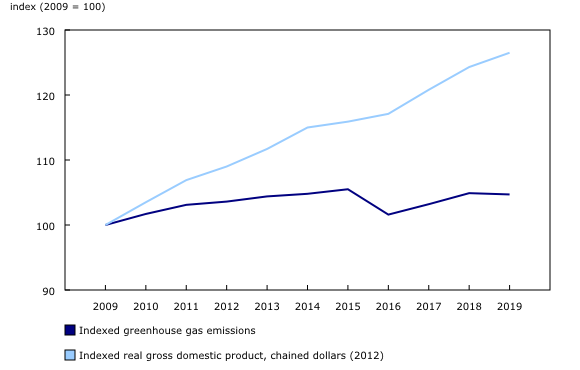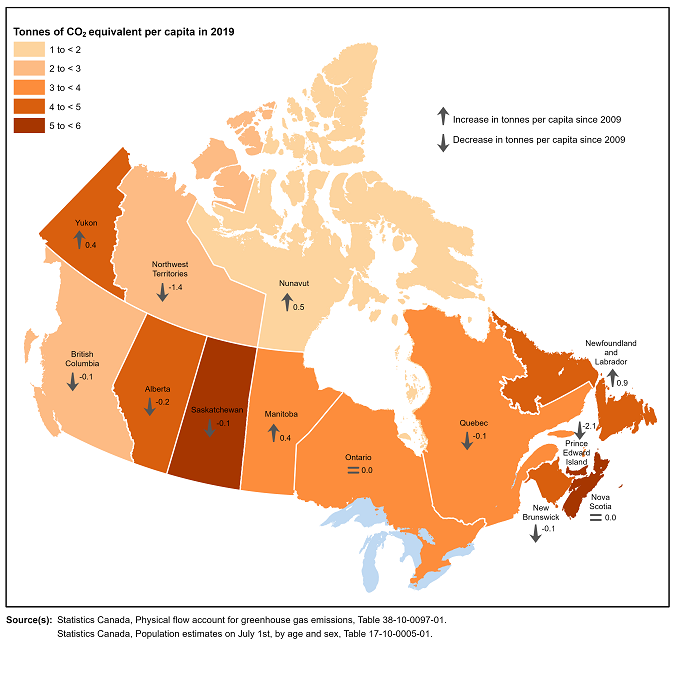Canadian System of Environmental–Economic Accounts: Energy use and greenhouse gas emissions, 2019
Archived Content
Information identified as archived is provided for reference, research or recordkeeping purposes. It is not subject to the Government of Canada Web Standards and has not been altered or updated since it was archived. Please "contact us" to request a format other than those available.
Released: 2021-12-13
Canada's economy has been growing at a faster pace than its industrial greenhouse gas (GHG) emissions over the past decade. The economy grew 2.4% a year on average from 2009 to 2019, while industrial GHG emissions rose about one-fifth (+0.5%) as fast. The main reason for the difference is how Canadians sourced energy to heat and power their homes and businesses over that decade.
The energy use and GHG emission data presented in this release reflect the economic activities of industries, households and governments that contributed to Canada's gross domestic product (GDP) in 2019. These data therefore reveal trends before the COVID-19 pandemic. Physical distancing measures and various restrictions on economic activity related to the pandemic have altered these trends, and changes will be confirmed once the data for 2020 become available.
These GHG emission estimates are based on the United Nations System of Environmental Economic Accounting (SEEA) guidelines and are closely linked to economic statistics. They differ from the GHG emission estimates released by Environment and Climate Change Canada (ECCC), which is responsible for producing the National Inventory Report on Greenhouse Gas Sources and Sinks in Canada. ECCC's inventory is the official benchmark for GHG emissions in Canada and is based on the guidelines from the United Nations Framework Convention on Climate Change.
For more information on the methodological differences between these two data products, see the note Complementary approaches to reporting Canada's greenhouse gas emissions.
The coal phase-out for electricity generation has lowered industrial greenhouse gas emissions
From 2009 to 2019, the Canadian economy (+26.5%) as measured by real GDP, the total energy used by industries (+10.2%) and industrial GHG emissions (+4.7%) all increased. However, emissions rose at about one-fifth the pace of economic growth and about half that of industrial energy use.
One reason why economic growth and the increase in industrial energy use have been faster than the rise in GHG emissions is that the electric power generation, transmission and distribution industry has been shifting away from coal toward less GHG-intensive energy sources for generating electricity. From 2009 to 2019, GHG emissions from this industry fell by 34.1%, while real GDP at basic prices for the industry rose 15.2%.
Overall, the intensity of direct industrial GHG emissions decreased 2.0% to 0.32 kilotonnes per million dollars of real GDP from 2018 to 2019, while direct industrial energy intensity decreased 1.7% to 4.64 terajoules per million dollars of GDP. Direct emissions are produced by industries when they burn fuel or through their other industrial processes.
The oil and gas extraction industry remains Canada's top industrial energy user
The oil and gas extraction industry remained Canada's top industrial energy user in 2019, using 17.3% of total energy. Oil and gas extraction was the highest GHG-emitting industry for the decade from 2009 to 2019, responsible for 20.7% of Canada's total GHG emissions in 2019.
Households account for almost one-quarter of the total energy used in Canada
The residential sector consumed almost one-quarter (23.6%) of Canada's total energy in 2019, up 0.1 percentage point from 2018. This amounted to 75.8 gigajoules of household energy use per person, or the equivalent of the energy required to run a typical refrigerator for about 44 years straight.
Although households accounted for almost one-quarter of the energy used in 2019, they were responsible for less than one-fifth (18.4%) of Canada's total GHG emissions in the same year, mainly because of the large share of household energy coming from electricity.
Household emissions per capita represent the average amount of household GHG emissions generated by a single person, excluding all industrial emissions. Examples of household final consumption include buying gasoline for a vehicle or natural gas to heat a home. A region's available fuel mix, climate, average household size and average household income all influence per capita emissions.
In 2019, Canada's per capita household GHG emissions decreased 0.4% to 3.8 tonnes per person.
For international context, other countries with SEEA-based air emission accounts, such as the United Kingdom, France and Germany, reported per capita household emissions ranging from 1.7 tonnes to 2.2 tonnes for 2019.
British Columbia has the lowest per capita household greenhouse gas emissions among the provinces, while Atlantic Canada has among the highest
At 2.9 tonnes per capita, British Columbia and the territories produced the lowest per capita household GHG emissions in 2019. Quebec (3.2 tonnes) and Manitoba (3.4 tonnes) were also below the national per capita level, while Ontario (3.8 tonnes) matched it.
Per capita household GHG emissions were highest in Saskatchewan (5.6 tonnes), Prince Edward Island (5.3 tonnes), Nova Scotia (5.1 tonnes), and Newfoundland and Labrador (5.0 tonnes). Alberta (4.9 tonnes) and New Brunswick (4.7 tonnes) were also above the national average.
Among the provinces, Newfoundland and Labrador (+0.9 tonnes) had the largest increase in per capita household GHG emissions from 2009 to 2019, while Prince Edward Island (-2.1 tonnes) had the largest decline.
Alberta greenhouse gas emissions driven by the oil and gas extraction industry
Variations in GHG emissions across Canada reflect the distinct land, geography and population of each province and territory.
Canada is a resource-rich country, and many resources are extracted and used domestically or exported. The extraction of many of these resources—whether they are renewable, such as those obtained from logging, or non-renewable, such as those from mining or the oil and gas industry—contributes to Canada's annual GHG emissions and to its economic growth.
The oil and gas extraction industry was the largest GHG-emitting industry in Alberta in 2019, accounting for 45.8% of the province's total emissions. Emissions from this industry grew 35.2% over the decade from 2009 to 2019, in tandem with resource development in that province.
Households are the largest emitters in Central Canada
In both Ontario (32.3%) and Quebec (29.6%), households were the greatest source of direct GHG emissions in 2019. An example of direct GHG emissions from households is exhaust from gasoline-powered cars.
Pulp, paper and paperboard mills account for one-fifth of emissions in British Columbia
Pulp, paper and paperboard mills (20.3%) and households (17.5%) were the largest sources of GHG emissions in British Columbia in 2019.
Crop and animal production are important contributors to emissions in several provinces
In 2019, crop and animal production industries accounted for the largest share of total GHG emissions in Manitoba (36.8%) and the second-largest share in Prince Edward Island (26.0%), after households (46.6%).
In Saskatchewan, almost three-quarters of total GHG emissions came from crop and animal production (25.5%); oil and gas extraction (22.6%); and electric power generation, transmission and distribution (21.2%).
The electric power generation, transmission and distribution industry and the oil and gas extraction industry are among the top emitters in Atlantic Canada
The electric power generation, transmission and distribution industry was the most significant source of GHG emissions in Nova Scotia (39.0%) in 2019. In New Brunswick, the highest contributors were households (21.9%); pulp, paper and paperboard mills (19.9%); and electric power generation, transmission and distribution (19.3%).
In Newfoundland and Labrador, households (23.0%) were the primary GHG emitters in 2019, followed by the oil and gas extraction industry (21.8%).
Mining industry is the largest greenhouse gas emitter in Nunavut and the Northwest Territories
The mining industry accounted for almost half of GHG emissions in Nunavut (46.3%) and almost one-third (32.4%) in the Northwest Territories in 2019.
In Yukon, households (27.3%) were responsible for over one-quarter of total GHG emissions, followed by metal ore mining (15.8%).
Note to readers
The basis for these greenhouse gas (GHG) estimates is Statistics Canada's physical flow accounts (PFA), which record the annual flows of selected natural resources, products and residuals between the Canadian economy and the environment. Data are presented to reflect the activities of industries, households and governments, and they follow the classification system of industries and commodities used in Statistics Canada's supply and use tables. Following the United Nations System of Environmental–Economic Accounting (SEEA), the use of this classification system enables the environmental accounts to be integrated with Canada's economic statistics, such as the gross domestic product.
Environment and Climate Change Canada is responsible for producing the official National Inventory Report on Greenhouse Gas Sources and Sinks in Canada. This inventory, which fulfills Canada's reporting obligations under the United Nations Framework Convention on Climate Change (UNFCCC), is consistent with guidelines published by the Intergovernmental Panel on Climate Change and is the official benchmark for GHG emissions in Canada. National inventories under the UNFCCC and the GHG accounts under the United Nations SEEA are based on different methodological frameworks that result in different GHG estimates. The sector definitions of the two products differ and should therefore not be directly compared. For more information on the methodological differences, see the Canadian System of Environmental–Economic Accounts—Physical Flow Accounts metadata page and the note Complementary approaches to reporting Canada's greenhouse gas emissions.
Preliminary data for 2019 from the PFA are now available for national energy use (38-10-0096-01) and national, provincial and territorial GHG emissions (38-10-0097-01). Estimates for 2009 to 2018 for energy use and GHG emissions were also updated with revised source data. Finally, estimates for 2009 to 2017 for energy use and GHG emissions have also been revised for direct plus indirect energy and GHG emission intensity, by industry (38-10-0098-01), and physical flows by final demand category (38-10-0010-01).
The products Physical flow account for energy use: Interactive tool and Physical flow account for greenhouse gas emissions: Interactive tool, both part of the Data Visualization Products series (71-607-X), are also available. For the latest in energy information in Canada, visit the Canadian Centre for Energy Information website.
Contact information
For more information, or to enquire about the concepts, methods or data quality of this release, contact us (toll-free 1-800-263-1136; 514-283-8300; infostats@statcan.gc.ca) or Media Relations (statcan.mediahotline-ligneinfomedias.statcan@statcan.gc.ca).
- Date modified:





